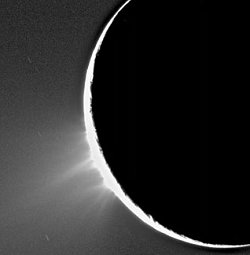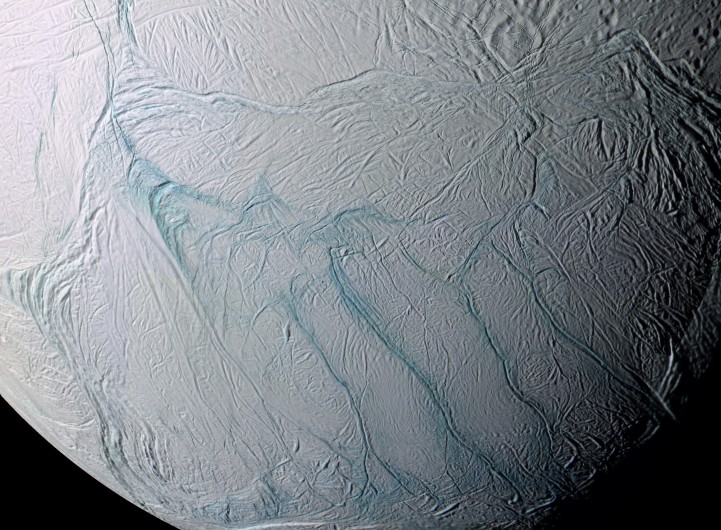We’ve all seen the beautiful Cassini images of plumes emanating from the surface of Enceladus. So that begs the question – how is Enceladus hot enough to produce liquid when the moon appears to be an icy wasteland?
In 2008 Cassini flybys of Enceladus led to the startling discovery of Enceladus’ plumes and the presence of cryovolcanic activity on the moon. Further investigations found that there are higher temperatures at the Tiger Stripe region of the moon, where the temperature is –93°C. This is at the very least 115°C warmer than other regions of Enceladus!
Enceladus’ plumes indicate the presence of a subsurface ocean or a vast store of water. Considering Saturn and it’s moons get just 1% of the sunlight that Earth gets, and the surface temperature is on average around -180oC to -220oC, how do you get liquid water? Clearly the presence of liquid water under the crust means there has to be an internal heat source somewhere on the planet. There are a couple of ideas:
- After the Voyager flyby of Jupiter in 1979, astronomers were shocked to find footage of active volcanoes on Io. At the time Io was thought far too small to be geologically active, however, as it turns out Io is the most volcanically active body observed in our Solar System. It achieves this activity by an action known as tidal heating. Orbital resonances between Io and the other major Jovian moons regularly stretch and deform the small moon. This stretching has the effect of kneading the interior of the moon, producing the energy to keep Io’s interior molten. It’s thought that this action could be at play deep inside Enceladus.
- However, only Titan has sufficient mass to have this effect on Enceladus, but it is too far away from the small planet to have a significant impact. Enceladus has an interesting relationship between its orbital period and its rotational period. Enceladus has a 1:4 spin-orbit coupling. That means that the moon rotates once per four orbits of Saturn. Our own moon has a 1:1 spin-orbit coupling, so that it rotates one per orbit of Earth. Enceladus spin-orbit coupling, together with its fairly close orbit to Saturn, would likely result in varying tidal stresses. These stresses would heat the interior of the moon, just as similar stresses heat Io’s interior.
- Radioactive decay is another possible source of internal heat for Enceladus. It appears that Enceladus has a sizeable rocky core, which means the presence of radioactive elements. Energy released through radioactive decay is a significant source of heat in bodies such as Earth and the other rocky planets. So the increased rock content could result in radioactive heating of Enceladus. However, at this stage we don’t think that there’s enough radioactive heating to account for a temperature sufficient to melt ice alone.
- Another possibility is the friction caused by the fault lines at the moon’s Tiger Stripes rubbing back and forth due to the gravitational force exerted by Saturn as the moon orbits the planet. This frictional force might be generating the heat required to sublimate the water that forms the plume.
- Another study says that two moons that orbit near Enceladus, Tethys and Dione gravitationally ‘pull’ Enceladus, and such ‘flexing’ over millions of years might have caused the moon to heat up. Such heating might contribute to the liquidation of water present on Enceladus, leading to the formation of the plume. There is a correlation between the geologically youthful surface fractures and the warm temperatures that have been recorded in the South Polar Region. The regions of heat previously detected appear to be confined to a narrow, intense region no more than a kilometre wide along the fracture. In these measurements, peak temperatures along Baghdad Sulcus exceed – 92°C and may be higher than -73°C. These warm temperatures probably result from heating of the fracture flanks by the warm, upwelling water vapor that propels the ice-particle jets. The fractures are cold by Earth standards, but they’re a warm compared to the -220 C, of their surroundings. The huge amount of heat pouring out of the tiger stripe fractures may be enough to melt the ice underground.
- A study published in Nature proposed another heating method, one that could provide large amounts of heat to maintain more energetic liquid oceans on distant moons. An oceanographer from the University of Washington, suggests that Jupiter may keep Europa’s oceans warm by generating large planetary waves on the moon. Since Europa tilts on its axis, a previously unconsidered kind of tidal force could generate planetary waves called Rossby waves. Although Rossby waves travel quite slowly, at just a few kilometers per day, they can generate significant kinetic energy. The same warming method could apply to other moons of Jupiter and Saturn.
Right now there’s not enough data to confirm the cause of warming definitively and so scientists aren’t definitively sure of the cause, however, the source of Enceladus’ heat is likely to be a combination of some or all of these factors.
Sharon
This article was written for Astro Space News.



